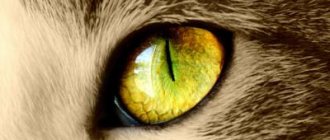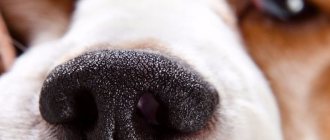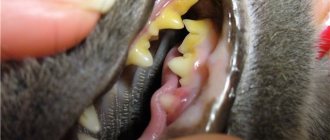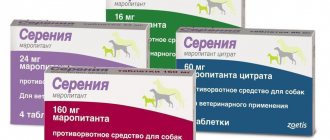Giardiasis in dogs and cats is a protozoal infection that affects many species of vertebrate animals. Cats, dogs and humans are also infected. The infection may be asymptomatic or manifested by diarrhea, malabsorption in the intestine, and weight loss.
Prevalence: Giardia occurs in 5% of healthy cats and dogs, and 15% in clinically ill animals. Young individuals are more often affected. No breed or gender predisposition was identified.
Who are Giardia?
It is not a worm, bacteria or virus. Giardia (Giardia) is a single-celled protozoan flagellated microorganism, one of the most common parasites of various animal species (cats, dogs, rodents) and birds.
Man is also on their list. Giardia has two nuclei and two sets of organelles - four pairs of flagella, two medial bodies - everything for simple reproduction by longitudinal division in half, which is what they do. By the way, in the picture these are not eyes, but just nuclei
The body of Giardia is pear-shaped - the front part is rounded and widened, the back part is pointed. The main feature of Giardia is the suction disk on the lower surface of the body. With its help, it attaches to the microvilli of the small intestine and begins to lead a parasitic lifestyle, feeding on the digested food of the host. This is the trophoziod (vegetative stage) of Giardia. It is this form that is invasive, pathogenic, and capable of reproduction. It is very sensitive to external conditions and dies immediately when they change.
Therefore, Giardia also has a second form of existence - cysts . This temporary form is characterized by a protective shell (the microorganism “pupates,” as it were), making it more resistant to adverse factors. Giardia cysts are resistant to low temperatures, but die instantly when boiled. Cysts love moisture; drying them in air for 24 hours leads to complete death. They can live in soil and water for several months. Cysts are resistant to ultraviolet radiation and chlorine.
It is the “cyst” form that serves to “transport” the parasite. Giardia, entering the large intestine from the small intestine, turns from trophosioda into cysts and is excreted along with feces.
Both forms enter the external environment, but only cysts survive!
What it is?
Giardia is the name given to microorganisms that parasitize the small intestine not only in cats, but also in many other animals. Carriers of these protozoa can be rodents, birds, dogs and even humans.
With the help of a special suction disk located on the abdomen, Giardia attaches to the intestinal mucosa and multiplies, feeding heavily on the digested food of the host. Traveling through the intestines in two forms - trophozoid (a form of Giardia that is capable of reproduction) and a cyst (a stable form with a shell, like the “pupa” of butterflies), the parasites can live in the cat’s body, as well as in soil and water, for many months.
These Giardia are very tenacious: they do not die during the day under the influence of UV rays, and they are not damaged by disinfection of the room with chlorine. Only a decrease in humidity can destroy these creatures. They leave the cat's body along with feces, which is extremely dangerous, since the owner often becomes infected with giardiasis.
How does giardiasis become infected?
It’s very simple - by the fecal-oral method (through contaminated water or food, through washing and licking the cat’s paws after visiting the tray, which was also used by the sick animal).
A cat becomes infected with giardiasis after ingesting cysts of the parasite. Stomach acid weakens their membrane, and once in the intestine, the cysts are converted back into trophozoids. This active form attaches to the intestinal wall and begins to feed and reproduce by division. When a sufficient number of Giardia accumulates, clinical signs of infection appear.
Danger of the disease for animals and humans
Giardia colonies that have settled in the intestines of animals attach to the walls and disrupt the epithelial layer. This causes disruption of intestinal motility, the functioning of its secretory and absorption functions. As a result of a lack of fats, vitamins, carbohydrates and other nutrients, cats become apathetic, drowsy, lose weight and lose their appearance.
Their immunity decreases, the appearance and quality of their skin and coat deteriorate, intestinal disorders become more frequent, and vitamin deficiency appears. The entry into the body of a large number of waste products of parasites can cause toxicological and allergic disorders. A lot of Giardia in the intestine causes mechanical damage, inflammation and erosion.
- development of persistent diarrhea;
- disruption of the pancreas;
- dysbacteriosis;
- pancreatitis;
- exhaustion.
In the absence of timely treatment for giardiasis, the cat looks tired and sick and may die over time.
Animals should not be allowed to jump on the dinner table or sleep on the family bed. It is better to burn the wool after combing. Cat food and drinking cups should be treated with boiling water from time to time.
Why is giardiasis dangerous?
Giardia, clinging to the intestinal walls, irritate its epithelial layer, disrupt secretory and motor functions, and interfere with the absorption of fats, carbohydrates and other substances.
By forcing the body to absorb the products of its vital activity, parasites cause toxic-allergic reactions. With an increase in the number of Giardia, the intestinal wall is gradually traumatized with the formation of microerosions with the presence of inflammation. This provokes a malabsorption of proteins, glucose, fats and fat-soluble substances, which in turn leads to vitamin deficiency, the development of dysbacteriosis and the appearance of diarrhea.
Sometimes, due to mechanical blockage of the pancreatic and liver ducts, pancreatitis occurs.
The accumulation of Giardia will aggravate the situation.
The danger of giardiasis in cats
Giardia in a cat irritates the intestinal mucosa, disrupts the secretion function, and slows down all motor processes in the animal’s gastrointestinal tract. In addition, these parasites interfere with the absorption of beneficial substances, forcing your pet’s body to absorb not the necessary vitamins and microelements, but the products of its vital activity. They cause allergies and intoxication in the animal.
Treatment of giardiasis in cats should begin as soon as the first signs of a change in the animal’s well-being appear. After all, the accumulation of Giardia injures the walls of the stomach and leads to ulcers and erosions. A pet can acquire chronic pancreatitis, develop vitamin deficiency and dysbacteriosis, or even die from dehydration, since diarrhea with giardiasis constantly makes itself felt.
Symptoms of giardiasis
Due to the small size of the parasites, symptoms may not appear immediately, but only appear when the Giardia itself and its toxic products become too numerous.
The severity of giardiasis and the range of its symptoms may vary from cat to cat. This depends on the infecting dose, the age of the animal (young people get sick more often), the state of the intestinal microflora, the presence of other diseases, the stability of the immune system in general, social factors, etc.
Of course, those at risk are walking cats and cats living in crowded conditions (kennels, shelters), animals with diseases of the immune system.
Symptoms of giardiasis may be subtle and manifest as minor intestinal disorders or general malaise. Sometimes it occurs without clinical signs.
Giardia can cause chronic diarrhea in cats. The animal's appetite usually does not change, and the weight decreases.
Stools can range from soft to watery, have a pale yellowish or greenish tint, have a foul odor, and sometimes contain blood or mucus. Diarrhea may be intermittent.
With a long course of the disease, the cat may have a deficiency of fat and other vitamins, which leads to dry skin and brittle hair.
Due to poisoning of the body with the products of parasite secretions, the animal may experience various types of allergic reactions.
In some cases, there is vomiting and a decrease in general activity.
Prevention of giardiasis in cats
Prevention of giardiasis in cats involves basic hygiene. It is advisable to wash your hands more often, especially after cleaning the litter box. Constant disinfection of surfaces is necessary. Regular chlorine bleach is suitable for this.
In those places where the cat is most often it is worth cleaning and drying. The tray must always be treated with boiling water. A similar procedure is carried out with bowls.
In this case, an epidemic of the disease can be easily avoided. It is important not to ignore these requirements. After all, many people don’t really take care of their animals. Therefore, one can only guess whether they have some diseases.
Timely hygiene measures, compliance with preventive rules and proper nutrition of the animal will not harm it. On the contrary, such an attitude will help protect against unwanted diseases. Giardiasis in cats is not so easy to cure, you need to understand this and not expose the animal to this disease.
Diagnosis of giardiasis
Giardiasis is confirmed by the presence of cysts or trophozoids of the parasite in the feces. Since Giardia does not come out with every portion of feces and in small quantities, it is necessary to study samples over several days. For stool analysis, the flotation (separation) method and/or the fecal smear method are used.
To detect Giardia, there are also special tests - enzyme-linked immunosorbent assay (ELISA), immunochromatographic test (IC), which allow you to quickly and reliably make a diagnosis. But the most accurate diagnostic method is polymerase chain reaction (PCR).
How to detect parasites?
In addition to the symptomatic component, when making a diagnosis, the veterinarian uses a special analysis - submitting stool or fecal smear for the content of protozoa, including Giardia. Giardia cysts or trophozoids do not always leave the cat’s body, so this analysis is done over several days, each time processing the samples under a microscope.
Since the treatment of Giardia in cats and dogs is quite popular, a special test was invented to detect only these parasites in the animal’s body - enzyme-linked immunosorbent assay (ELISA) or immunochromatographic test (IC). It is done in any veterinary clinic or laboratory.
Treatment of giardiasis
Giardiasis can be treated, but the fight against it must be carried out in a timely and competent manner. Therefore, when your pet develops symptoms, we go to the doctor!
Giardia are parasites, and they are expelled by antiparasitic drugs. Simple anthelmintic drugs will not help here; an antibiotic is required.
The most commonly used is metronidazole, less commonly tinidazole and furazolidone, or a combination thereof.
Together with them, enterosorbents (to remove toxins) and probiotics (to improve intestinal microflora) are prescribed, and a special diet is also desirable.
The usual course of treatment is 7-10 days. To ensure the effectiveness of treatment, repeat tests are done.
Giardia in cats is more resistant to treatment than, for example, in dogs. Therefore, sometimes several courses of treatment or replacement of drugs are required.
The journal “Veterinary Focus” (2009, No. 19.1) describes a case where, based on test results, a cat was confidently diagnosed with giardiasis and treated with metronidazole. At first the severity of the diarrhea decreased, but 10 days after treatment the condition worsened again. It turned out that the free-roaming cat sometimes played in the yard with the kitten. Both cats were additionally treated with fenbendazole, bathed and dried (to exclude the presence of cysts in the fur), litter trays and cat walking areas were disinfected. Only after this the symptoms disappeared, fecal tests (including repeated tests three weeks later) gave a negative result, and there were no further complaints.
Can you get infected from a cat?
Giardia cati is Giardia in cats, belonging to a separate biological species, different from the single-celled ones characteristic of the human form of the disease. The overwhelming majority of protozoa that parasitize the body of cats are not dangerous to humans, but there are common types of pathogens that can infect people. In medical practice, cases of human infection with giardiasis due to close contact with animals have been recorded. Finding a cat without pathology is difficult; even a newborn kitten can have giardiasis or coccidiosis transmitted by a sick mother. Pets are natural carriers of parasitic diseases, so old people, children, and people with weak immune systems should especially stay away from sick animals.
Prevention of infection
Following good hygiene and nutrition will help prevent illness or reduce the risk of complications.
- It is better not to let a domestic cat outside.
- For feeding you need to set aside a special place. Food should only be placed in a bowl (not thrown on the floor), which should be periodically doused with boiling water.
- There is no need to ignore preventive vaccinations.
- After going to the toilet, the cat must be washed so that no cysts remain on the fur.
- The tray must be kept clean. Street sand cannot be used as a filler.
- If there are other pets in the house, they must be isolated.
It is necessary to closely monitor the health of your pet. If suspicious signs are detected, it is better to show the animal to a veterinarian. This will avoid complications and the spread of the disease to humans.
Causes
Giardia in cats, humans and other warm-blooded animals are microscopic parasitic organisms that enter the body through the fecal-oral route, that is, by ingesting cysts of this parasite. Its cysts (that is, the parasite in an inactive state) remain capable of infection for more than two months, when outside the host’s body. At the same time, they have high viability and tolerate even negative environmental conditions, such as heating up to 70 degrees. Therefore, it is quite easy to become infected with them, and in cats this can happen for the following reasons:
- Drinking raw water from a tap or reservoir, as it may contain cysts;
- Eating raw meat;
- Eating poorly washed vegetables, as the parasite can remain on soil particles;
- Contact with an infected animal, as parasites may be on its fur;
- Contact directly with the feces of an infected person;
- Contact with contaminated soil, which is typical for animals walking outside.
Giardiasis in cats, as can be seen from the description, often develops in cases where the animal walks outside. However, domestic cats can also become infected, since cysts can land on the owner’s shoes and clothes and thus enter the apartment.
Therapeutic actions
If other parasitic diseases are treated with anthelmintic drugs, then in the case of giardiasis, antibiotics cannot be avoided.
- Metronidazole. The drug is an antibiotic with a wide spectrum of action. Contraindications to its use are pregnancy, lactation, liver disease. Cats are usually given the required dose once every 12 hours. For 1 kg of weight you need to take 10 ml of suspension.
- Tinidazole. The drug belongs to the group of antibiotics that are active against many parasites. The dosage is 1/4 tablet once a day for 5-10 days.
- Furazolidone. The medicine has extensive antimicrobial action. The required dosage is mixed with the food.
- Dirofen. Combined anthelmintic agent. The tablet is given once before morning feeding. The dosage is equal to one tablet per 5 kg of body weight. There is no need to follow a diet or take laxatives beforehand.
- Alben. The anthelmintic drug is given with food in the morning. The dose is equal to one tablet per 5 kg of weight. If the cat weighs less than 2.5 kg, then the tablet is diluted in water, and the dosage is 1 ml per 0.5 kg of body weight. Do not give to kittens under three weeks of age, pregnant women or during lactation.
- Ornidazole. The medicine has antibacterial and antiprotozoal effects. Prescribe intramuscular or subcutaneous administration of 5 mg per 1 kg of weight. Do not use if the cat has serious kidney or liver disease.
- Fenbendazole. The drug has the least toxicity; treatment of parasites during pregnancy and feeding of kittens is allowed. The dosage is 50 mg per 1 kg of animal body weight once a day for five days.
- Nemozol. The drug should be given with caution to cats that have liver problems. The course of treatment lasts no more than two days. The dosage is 25 mg per 1 kg. If necessary, the course of treatment can be repeated after a week.
During the period of treatment and recovery, you need to adhere to a diet. You should not give your cat fatty foods, dairy products, eggs, and dry food is prohibited. Chicken broths with vegetables are welcome.
To cleanse the body, enterosorbents, probiotics, and hepatoprotectors are additionally prescribed. To increase the body's defenses, immunomodulators and vitamin-mineral complexes can be used.
Treatment for giardiasis in cats usually lasts about two weeks. Afterwards, a stool test is taken again. Sometimes several courses of therapy are required for complete recovery, and it may be necessary to change the drug.
If not treated in time, the body experiences a lack of vital nutrients. Hemoglobin decreases, anemia develops. Calcium decreases, rickets develops. Inflammatory diseases of the eyes and ears (conjunctivitis, otitis media) may occur. Symptoms of gallstone disease begin to bother you.
How cats become infected with Giardia
It is very easy to become infected with giardiasis. This is a fecal-oral route of infection. For example, a cat went to the litter box and relieved itself, washing itself, they lick their paws after using the toilet, which was used by a cat infected with Giardia.
Cats have their own Giardia, but animal fur may contain cysts of the human parasite.
There is another way of infection - nutritional. Infection occurs through food. Giardia lives in drinking unboiled water. Chlorine and ultraviolet radiation are “not able” to defeat them. River fish also suffer from giardiasis. And cats, as you know, are big fish lovers!
The parasite's body looks like a pear. In front, in the wide part of the body, there are two nuclei. The back of the lamblia is narrowed. Giardia parasitizes the small intestine. With the help of a suction disk, it clings to the intestinal villi and sucks in the digested food of the host. This form of Giardia is called trophozoid (vegetative stage). Trophozoids are pathogenic and capable of reproducing. When conditions change, it dies.
But it's not that simple. Parasites have another form of existence. Cyst is the “pupated” stage of a microorganism. This is necessary so that it is resistant to adverse factors. In this form they are able to survive the winter. But the cysts die from high temperatures. So boiling water kills them completely.
Good to know
- Concentration of vitamins in serum in dogs and cats with diseases of the gastrointestinal tract
- Coronavirus enteritis in cats
- Enemas and laxatives for cats and dogs
- Foreign bodies of the esophagus in cats and dogs
- Campylobacteriosis of dogs and cats (Campylobacter jejuni)
- Abdominal carcinomatosis in cats and dogs
- Volvulus of the mesentery and intestines in cats and dogs
- Clostridia in dogs and cats
- Coccidiosis in cats and dogs
- Constipation in dogs and cats
- Cricopharyngeal dysfunction (achalasia) in dogs and cats
- Coronavirus enteritis of dogs (etiology, signs, diagnosis and treatment)
- Feline infectious peritonitis - FIP
- Infusion therapy for cats and dogs for diseases of the gastrointestinal tract
- Cryptosporidiosis in dogs and cats (etiology, symptoms, diagnosis, treatment)
- Roundworms (roundworms) in cats and dogs
- Infiltrative diseases of the stomach in dogs and cats (neoplasia)
© VetConsult+, 2020. The use of any materials posted on the site is permitted provided there is a link to the resource. When copying or partially using materials from the pages of the site, be sure to place a direct hyperlink open to search engines, located in the subtitle or in the first paragraph of the article.
(c) Veterinary center for the treatment and rehabilitation of animals “Zoostatus”.
Varshavskoe highway, 125 building 1.
There are about 41 types of Giardia (Giardia), of which only one type - Giardia Felis - parasitizes only cats and is not transmitted to humans or other animals.
Giardiasis in cats is a parasitic disease caused by flagellated protists that parasitize the small intestine. These organisms can have two types of existence: in the form of trophozoites - actively moving organisms that live only in moist intestinal conditions, and in the form of cysts - more stable in the environment and protected by the shell of resting forms of parasites. Trophozoites can become cysts in the large intestine, then be excreted in feces and travel for a long time in the outside world before re-infection or infection with a new host.
Description
Giardiasis is a disease caused by flagellated protists that parasitize the small intestine as cysts or trophozoites.
Cysts are the resting form of the parasite. They have a protective shell that is resistant to external influences. Excreted in feces, cysts remain viable for more than 2-3 months. And when they enter the body of a new host, they are transformed into trophozoites and begin to actively reproduce. Trophozoites live only in the moist environment of the intestine; if they enter the environment with feces, they quickly die.
Giardia is neither a bacteria nor a virus or worm. Therefore, treating giardiasis in an animal with antibiotics or anthelmintic drugs is not effective. Immediate death of the microorganism occurs upon contact with boiling water. When heated to 60-70 degrees, they die only after 5-10 minutes. It is impossible to destroy cysts by treating them with chlorine or UV rays, but they are afraid of dry air.
Constantly multiplying, Giardia covers the entire surface of the intestinal walls, which leads to a decrease in its secretory function and disruption of the absorption of fats, carbohydrates, and fat-like substances. As a result of exposure to pathogens, irritation of the duodenum occurs. Mass death of Giardia, caused by taking special medications, leads to poisoning of the animal's body with toxins.
Symptoms of Giardia in a cat
Often the first period is asymptomatic in cats; it is not at all easy to classify the symptoms and carry out treatment on your own. Due to the small number of microorganisms, they are not able to adversely affect the intestinal microflora. Rare cases of loose stools. Gradually, your pet may develop the following symptoms:
- diarrhea. Rare or systematic, loose or soft stools with a pungent and unpleasant odor. Sometimes the animal's feces turn green or contain blood;
- weight loss. A kitten infected with Giardia begins to lag in growth. Adult animals simply lose weight, although their appetite remains normal and stable;
- some cats start vomiting;
- dry skin. Due to the vital activity of Giardia, the content of vitamins in the cat’s body decreases. This leads to brittle hair and dry skin;
- lethargy. In general, due to poor health, cats become less active and become much less playful than before;
- allergies. When protozoa remain in the body for a long time, cats develop allergic reactions.











